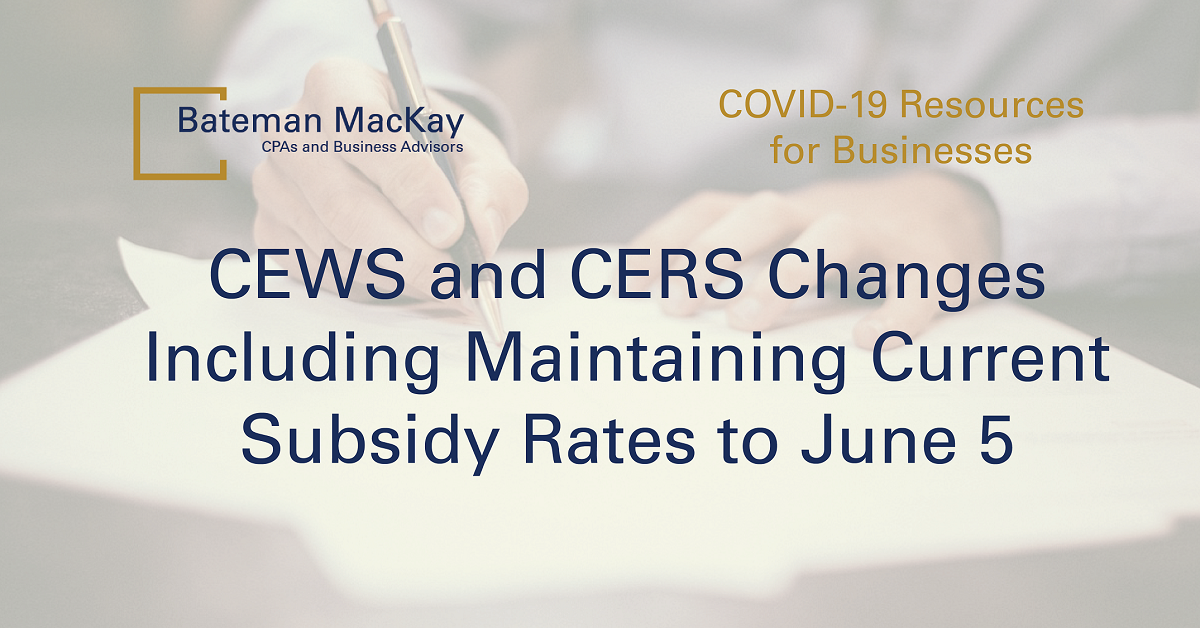
The Federal Government intends to make multiple changes to both the Canada Emergency Wage Subsidy (CEWS) and Canada Emergency Rent Subsidy (CERS) which would make the subsidies more accessible for more employers. The most significant of these changes is the restructuring of the sliding scale reductions of subsidy percentages. Instead of a gradual month-to-month reduction of the percentage of subsidy available, both subsidies, including the CERS Lockdown Support, will remain at their current rates until June 5th.
The proposed rates for CEWS, CERS, and Lockdown Support to Period 16 (ends June 5):
Calculation Reminder
A full explanation of how CEWS is calculated is available here. The program includes a 40% sliding scale based on year-over-year revenue decrease and ranges from .8% to 40%. There is an additional sliding scale Top-up rate to bring the maximum possible subsidy to 75%.
A full explanation of how CERS is calculated is available here. This rent subsidy includes a sliding scale based on year-over-year revenue decrease and ranges from .8% to 65%. There is an additional 25% Lockdown Support if the business has been temporarily forced to close due to a public health order.
Additional CEWS Changes
Reference Periods – As the economic restrictions due to the pandemic are coming to the end of a full year, the Federal Government has announced that applicants can continue to use pre-pandemic 2019 reference months for the upcoming periods 14, 15 and 16 (March 14 - June 5).
For example, in Period 14 (March 14, 2021 – April 10, 2021), the general approach will compare revenues of March 2021 to March 2019 or February 2021 to February 2019. The alternative approach would compare March 2021 or February 2021 revenues to an average of January and February 2020 revenues.
Employers must continue to use the same revenue comparison approach that they have used for previous periods.
Minimum Revenue Decline for Period 11 – The reference period is the same for Periods 10 and 11 (December 2020 to December 2019 by default), so the Federal government has proposed that the revenue decline for Period 11 cannot be less than the applicant’s revenue decline for the 9th Period. Effectively providing the same subsidy amount in Period 11 as Period 9 or 10, whichever had the larger percentage of revenue decline.
Alternative Baseline Remuneration Computation – For periods 14, 15, and 16 (March 14 – June 5) employers can use an additional elective alternative baseline remuneration computation for furloughed or active non-arm’s length employees. An employer can use either March 1, 2019, to June 30, 2019, or July 1, 2019, to December 31, 2019, to calculate the baseline remuneration for these periods instead of the default January 1, 2020, to March 15, 2020.
The government has designed the CEWS rate structure to align with the Employment Insurance program which will continue to June 5, 2021. Eligible employers can continue to claim a weekly wage subsidy for furloughed workers equal to the lesser of:
Other CERS/Lockdown Support Changes
Lockdown Support for Non-Arms Length Businesses – The Federal Government is proposing a change in the Lockdown Support guidelines to allow a business that meets the Lockdown Support criteria and which pays rent to a Non-Arms Length business to qualify for the 25% Lockdown Support. This change would apply as of September 27, 2020.
For example, a person who owns a business that must be closed due to a COVID-19 related public health order, which pays rent to a property company that they also own, may now be eligible for Lockdown Support.
As the pandemic continues and the Federal Government continually modifies its Federal support programs, these tax measures just seem to increase in complexity. If you have any questions regarding these changes or other COVID-19 Federal Support Programs, please reach out to your Bateman Mackay LLP Business Advisor.
Sign up for our newsletter and receive tax, accounting, and business advisory resources for your business!